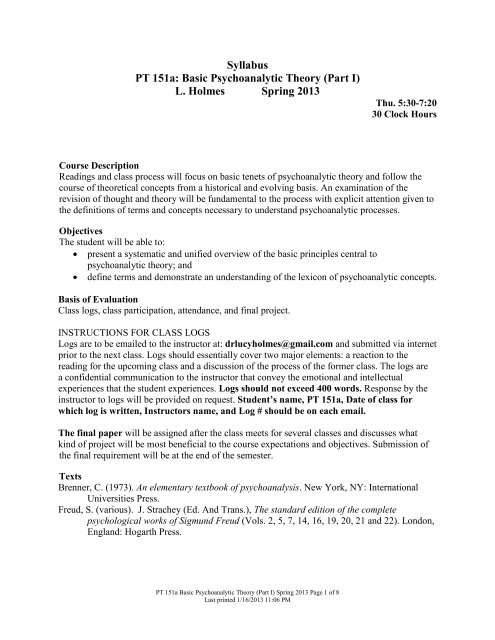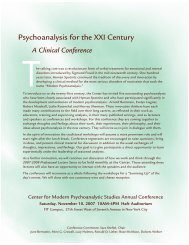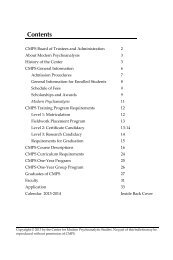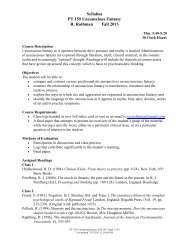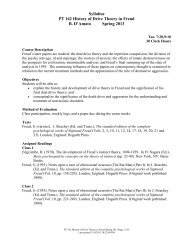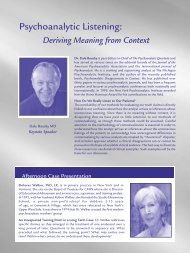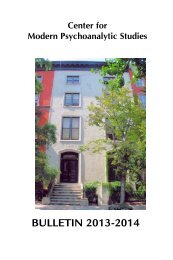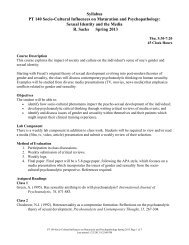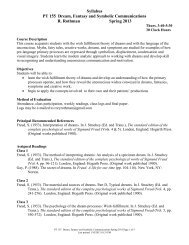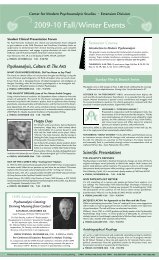Syllabus PT 151a: Basic Psychoanalytic Theory (Part I) L. Holmes ...
Syllabus PT 151a: Basic Psychoanalytic Theory (Part I) L. Holmes ...
Syllabus PT 151a: Basic Psychoanalytic Theory (Part I) L. Holmes ...
You also want an ePaper? Increase the reach of your titles
YUMPU automatically turns print PDFs into web optimized ePapers that Google loves.
<strong>Syllabus</strong><strong>PT</strong> <strong>151a</strong>: <strong>Basic</strong> <strong>Psychoanalytic</strong> <strong>Theory</strong> (<strong>Part</strong> I)L. <strong>Holmes</strong> Spring 2013Thu. 5:30-7:2030 Clock HoursCourse DescriptionReadings and class process will focus on basic tenets of psychoanalytic theory and follow thecourse of theoretical concepts from a historical and evolving basis. An examination of therevision of thought and theory will be fundamental to the process with explicit attention given tothe definitions of terms and concepts necessary to understand psychoanalytic processes.ObjectivesThe student will be able to:• present a systematic and unified overview of the basic principles central topsychoanalytic theory; and• define terms and demonstrate an understanding of the lexicon of psychoanalytic concepts.Basis of EvaluationClass logs, class participation, attendance, and final project.INSTRUCTIONS FOR CLASS LOGSLogs are to be emailed to the instructor at: drlucyholmes@gmail.com and submitted via internetprior to the next class. Logs should essentially cover two major elements: a reaction to thereading for the upcoming class and a discussion of the process of the former class. The logs area confidential communication to the instructor that convey the emotional and intellectualexperiences that the student experiences. Logs should not exceed 400 words. Response by theinstructor to logs will be provided on request. Student’s name, <strong>PT</strong> <strong>151a</strong>, Date of class forwhich log is written, Instructors name, and Log # should be on each email.The final paper will be assigned after the class meets for several classes and discusses whatkind of project will be most beneficial to the course expectations and objectives. Submission ofthe final requirement will be at the end of the semester.TextsBrenner, C. (1973). An elementary textbook of psychoanalysis. New York, NY: InternationalUniversities Press.Freud, S. (various). J. Strachey (Ed. And Trans.), The standard edition of the completepsychological works of Sigmund Freud (Vols. 2, 5, 7, 14, 16, 19, 20, 21 and 22). London,England: Hogarth Press.<strong>PT</strong> <strong>151a</strong> <strong>Basic</strong> <strong>Psychoanalytic</strong> <strong>Theory</strong> (<strong>Part</strong> I) Spring 2013 Page 1 of 8Last printed 1/16/2013 11:06 PM
Dictionaries & Reference BooksEidelberg, L., ed. (1968). Encyclopedia of psychoanalysis. New York, NY: The Free Press.Erwin, E., ed. (2002). The Freud encyclopedia: <strong>Theory</strong>, therapy, and culture. New York, NY:Routledge.Fenichel, O. (1945). The psychoanalytic theory of neurosis. New York, NY: W.W. Norton.LaPlanche, J., & Pontalis, J.B. (1973). The language of psychoanalysis. New York, NY: W.W.Norton.Moore, B., & Fine, B. (1990). <strong>Psychoanalytic</strong> terms and concepts. New Haven, CT: YaleUniversity Press.Nersession, E., & Kopff, R. (Eds.). (1996). Textbook of psychoanalysis. Washington, DC:American Psychiatric Association Press.Skelton, R.M. (Ed.). (2006). The Edinburgh international encyclopedia of psychoanalysis. NewYork, NY: Columbia University Press.Assigned ReadingsClass 1Brenner, C. (1973). Two fundamental hypotheses. In An elementary textbook of psychoanalysis(pp. 1-15). New York, NY: International Universities Press.Freud, S. (1963). Introductory lectures on psychoanalysis. In J. Strachey (Ed. And Trans.), Thestandard edition of the complete psychological works of Sigmund Freud (Vol. 15, pp. 15-24). London, England: Hogarth Press. (Original work published 1916-17)Class 2Brenner, C. (1973). The drives. In An elementary textbook of psychoanalysis (pp. 16-33). NewYork, NY: International Universities Press.Freud, S. (1959). Psychoanalysis. In J. Strachey (Ed. And Trans.), The standard edition of thecomplete psychological works of Sigmund Freud (Vol. 20, pp. 263-270). London,England: Hogarth Press. (Original work published 1925)Class 3Brenner, C. (1973). The psychic apparatus. In An elementary textbook of psychoanalysis (pp. 34-61). New York, NY: International Universities Press.Freud, S. (1953). Three essays on the theory of sexuality: Infantile sexuality. In J. Strachey (Ed.And Trans.), The standard edition of the complete psychological works of Sigmund Freud(Vol. 7, pp. 173-206). London, England: Hogarth Press. (Original work published 1905)Class 4Brenner, C. (1973). The psychic apparatus (continued). In An elementary textbook ofpsychoanalysis (pp. 62-105). New York, NY: International Universities Press.<strong>PT</strong> <strong>151a</strong> <strong>Basic</strong> <strong>Psychoanalytic</strong> <strong>Theory</strong> (<strong>Part</strong> I) Spring 2013 Page 2 of 8Last printed 1/16/2013 11:06 PM
Class 5Brenner, C. (1973). The psychic apparatus (concluded). In An elementary textbook ofpsychoanalysis (pp. 106-137). New York, NY: International Universities Press.Freud, S. (1964). Anxiety and instinctual life. In J. Strachey (Ed. And Trans.), The standardedition of the complete psychological works of Sigmund Freud (Vol. 22, pp. 81-111).London, England: Hogarth Press. (Original work published 1933)Class 6Brenner, C. (1973). Parapraxes and wit. In An elementary textbook of psychoanalysis (pp. 138-161). New York, NY: International Universities Press.Freud, S. (1957). Mourning and melancholia. In J. Strachey (Ed. And Trans.), The standardedition of the complete psychological works of Sigmund Freud (Vol. 14, pp. 237-257).London, England: Hogarth Press. (Original work published 1917)Class 7Brenner, C. (1973). Dreams. In An elementary textbook of psychoanalysis (pp. 162-185). NewYork, NY: International Universities Press.Freud, S. (1958). The psychology of the dream-processes. In J. Strachey (Ed. And Trans.), Thestandard edition of the complete psychological works of Sigmund Freud (Vol. 5, pp. 509-532). London, England: Hogarth Press. (Original work published 1900)Class 8Brenner, C. (1973). Psychopathology. In An elementary textbook of psychoanalysis (pp. 186-209). New York, NY: International Universities Press.Freud, S. (1961). Two classes of instincts. In J. Strachey (Ed. And Trans.), The standard editionof the complete psychological works of Sigmund Freud (Vol. 19, pp. 40-47). London,England: Hogarth Press. (Original work published 1932)Class 9Freud, S. (1959). The question of lay analysis. In J. Strachey (Ed. And Trans.), The standardedition of the complete psychological works of Sigmund Freud (Vol. 20, pp. 183-258).London, England: Hogarth Press. (Original work published 1926)Class 10Sternbach, O. (1975). Aggression, the death drive and the problem of sadomasochism. Areinterpretation of Freud’s second drive theory. International Journal of Psychoanalysis,56, 321-333.Meadow, P. (1987). The myth of the impersonal analyst. Modern Psychoanalysis, 12, 131-150.Class 11Spotnitz, H. (1985). Introduction. In Modern psychoanalysis of the schizophrenic patient (pp. 15-39). New York, NY: Human Sciences Press.Rosenfeld, H.A. (1971). A clinical approach to the psychoanalytic theory of the life & deathinstincts: An investigation into the aggressive aspects of narcissism. InternationalJournal of Psychoanalysis, 52, 169-178.<strong>PT</strong> <strong>151a</strong> <strong>Basic</strong> <strong>Psychoanalytic</strong> <strong>Theory</strong> (<strong>Part</strong> I) Spring 2013 Page 3 of 8Last printed 1/16/2013 11:06 PM
Class 12Bollas, C. (2007). What is theory? In The Freudian moment (pp. 71-83). London, England:Karnac Books.Shepherd, M. (2012). Speaking the unspoken: The challenge of id analysis. ModernPsychoanalysis, 37, 1-38.<strong>PT</strong> <strong>151a</strong> <strong>Basic</strong> <strong>Psychoanalytic</strong> <strong>Theory</strong> (<strong>Part</strong> I) Spring 2013 Page 4 of 8Last printed 1/16/2013 11:06 PM
Additional Selected Readings:Abraham, K. (1919). Selected papers. London, England: Hogarth Press. 1951.Bettelheim, B. (1982). Freud and man’s soul. New York, NY: Vintage Books.Bollas, C. (1992). Being a character: Psychoanalysis and self experience. New York, NY: Hill& Wang.Edelman, G. (1992). Bright air, brilliant fire: On the matter of the mind. New York, NY: <strong>Basic</strong>Books.Forrester, J. (1997). Truth games: Lies, money, and psychoanalysis. Cambridge, MA: HarvardUniversity Press.Frattaroli, E. (2001). Healing the soul in the age of the brain. New York, NY: Viking.Freud, S. (1955). Beyond the pleasure principle. In J. Strachey (Ed. And Trans.), The standardedition of the complete psychological works of Sigmund Freud (Vol. 18, pp. 24-64).London, England: Hogarth Press. (Original work published 1920)Freud, S. (1959). Inhibitions, symptoms & anxiety. In J. Strachey (Ed. And Trans.), Thestandard edition of the complete psychological works of Sigmund Freud (Vol. 20, pp. 87-156). London, England: Hogarth Press. (Original work published 1926)Freud, S. (1961). Civilization and its discontents. In J. Strachey (Ed. And Trans.), The standardedition of the complete psychological works of Sigmund Freud (Vol. 21, pp. 117-145).London, England: Hogarth Press. (Original work published 1930)McDougall, J. (1985). Theaters of the mind: Illusion and truth on the psychoanalytic stage. NewYork, NY: Brunner/Mazel.Ogden, T. (1983). The concept of internal object relations. International Journal ofPsychoanalysis, 64, 227-241.Sandler, J. (1987). The concept of projective identification. In Projection, identification,projective identification J. Sandler, ed. Madison, CT: International Universities Press.(pp. 13-26).Sandler, J. (1991). On Freud's "Analysis terminable and interminable." New Haven, CT: YaleUniversity Press.Spotnitz, H., & Meadow, P.W. (1995). Treatment of the narcissistic neuroses. Northvale, NJ:Jason Aronson.<strong>PT</strong> <strong>151a</strong> <strong>Basic</strong> <strong>Psychoanalytic</strong> <strong>Theory</strong> (<strong>Part</strong> I) Spring 2013 Page 5 of 8Last printed 1/16/2013 11:06 PM
AN OUTLINE OF BASIC CONCE<strong>PT</strong>S:THE THREE DOMAINS OF PSYCHOANALYSISI. Psychoanalysis as a theory of personality and development1. The dynamic (qualitative) viewa. consciousb. reflective consciousc. unconscious1. preconscious2. dynamic unconscious (repressed)3. primary process2. The structural (topographical) viewa. idb. egoc. superego1. Oedipus complex2. internalization of parental imagoesa. toxic introjectsb. castration anxiety3. incest prohibition4. split between sensual and affectionate components of love3. The economic (quantitative) view (Eros and Thanatos)a. Repetition compulsion1. pleasure principle2. reality principlea. principle of self preservation3. death drive4. Libido theorya. cathexisb. countercathexisc. hypercathexisd. fixation5. The stages of psychosexual development and character formationa. primary narcissismb. polymorphous perversec. oral erotic (sucking)d. oral sadistic (biting)e. anal erotic (expulsive)f. anal sadistic (retentive)g. phallich. latency periodi. genital phase6. Drives and instinctsa. Aggression (motor action) and anger (emotion)1. hostile vs loving (emotion) (motive)2. active vs passive (behavior) (means)3. destructive vs constructive (outcome)<strong>PT</strong> <strong>151a</strong> <strong>Basic</strong> <strong>Psychoanalytic</strong> <strong>Theory</strong> (<strong>Part</strong> I) Spring 2013 Page 6 of 8Last printed 1/16/2013 11:06 PM
7. Trauma and anxietya. Objective anxiety (fear)b. Neurotic anxietyc. Moral anxiety (guilt)8. Narcissisma. Absolute (in utero)b. Primary (infancy)c. Secondary (autoerotism)d. Egoistic (self regard)II.Psychoanalysis as a method of research and understanding1. The principle of psychological determinisma. Free association2. The ahistorical view3. Truth and reality4. Psychoanalyzing is a method of inferencea. To render the unconscious, consciousb. To render the subjective, objective5. Interpretation and the search for meaninga. Dreamsb. Symbolism and metaphorc. Psychopathology of everyday life6. Psychodynamicsa. projectionb. introjectionc. identificationd. projective identificatione. regressionf. substitutiong. undoingh. sublimationi. rationalizationj. fusionk. repressionl. reaction formationm. inhibition and symptom formationn. frustrationo. conflictp. denialIII. Psychoanalysis as a method and theory of treatment1. Catharsis (speaking one’s mind)2. Abreaction (reliving a traumatic experience)3. Transferencea. narcissisticb. object4. Repetition, recollection and acting out<strong>PT</strong> <strong>151a</strong> <strong>Basic</strong> <strong>Psychoanalytic</strong> <strong>Theory</strong> (<strong>Part</strong> I) Spring 2013 Page 7 of 8Last printed 1/16/2013 11:06 PM
5. Counter-transferencea. subjectiveb. objective6. Resistances and counter-resistances (sources)a. egob. idc. superegod. unconsciouse. repetition (status quo)f. characterg. narcissismh. realityi. treatment destructive7. Joining, mirroring, reflecting8. Emotional communication9. Corrective emotional experiencea. narcissistic wound (rejection)b. narcissistic supply (affirmation)c. unconditional acceptanced. Toxoid inoculation10. Progressive communication11. Working through12. Anaclitic counter-transferencea. empathic understanding13. <strong>Basic</strong> rulesa. say everythingb. be truthful14. Abstinence rulesa. no action, just wordsb. postpone gratificationc. no acting out15. Evenly hovering attention16. Uncathected intervention17. The use of the couch<strong>PT</strong> <strong>151a</strong> <strong>Basic</strong> <strong>Psychoanalytic</strong> <strong>Theory</strong> (<strong>Part</strong> I) Spring 2013 Page 8 of 8Last printed 1/16/2013 11:06 PM


